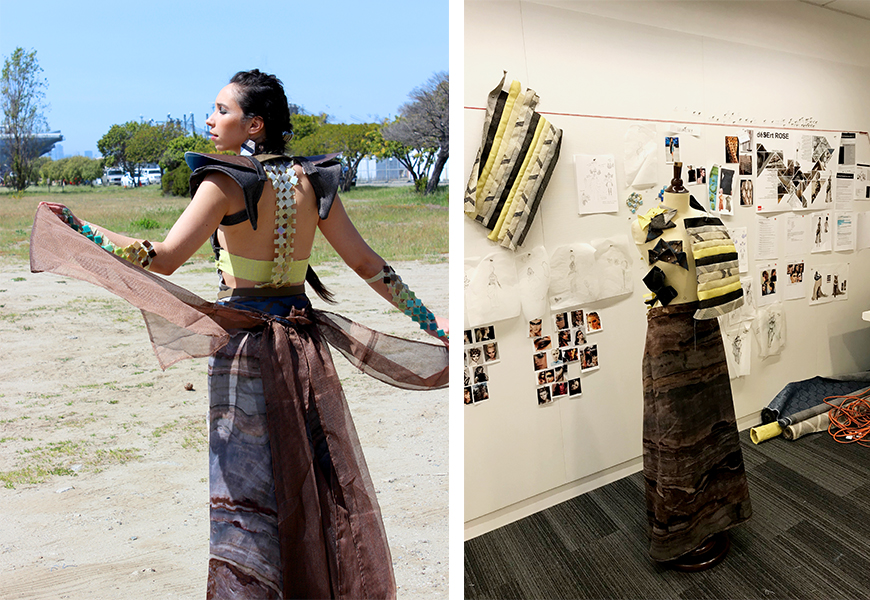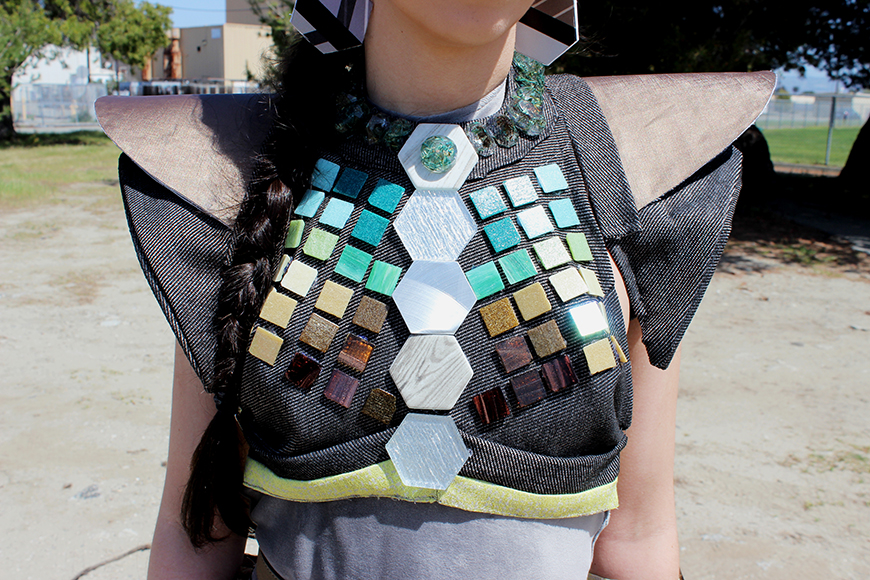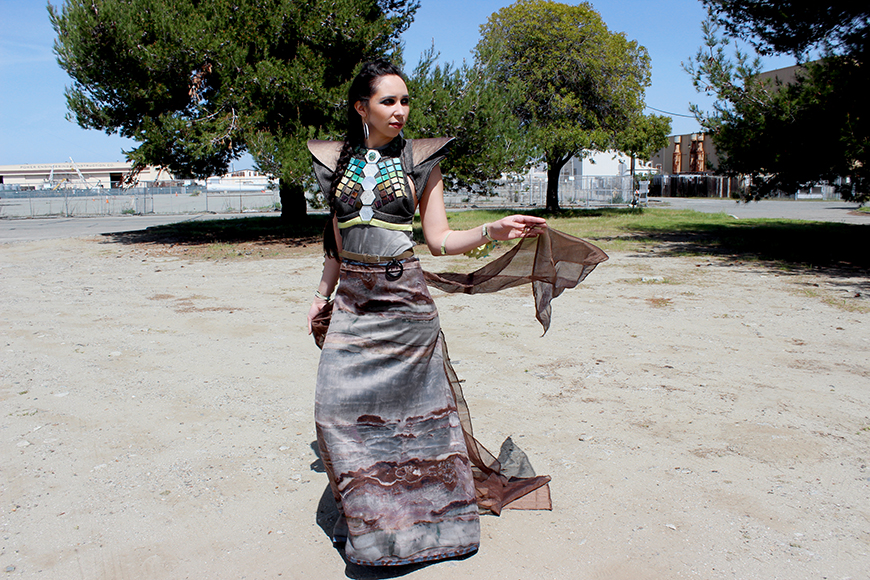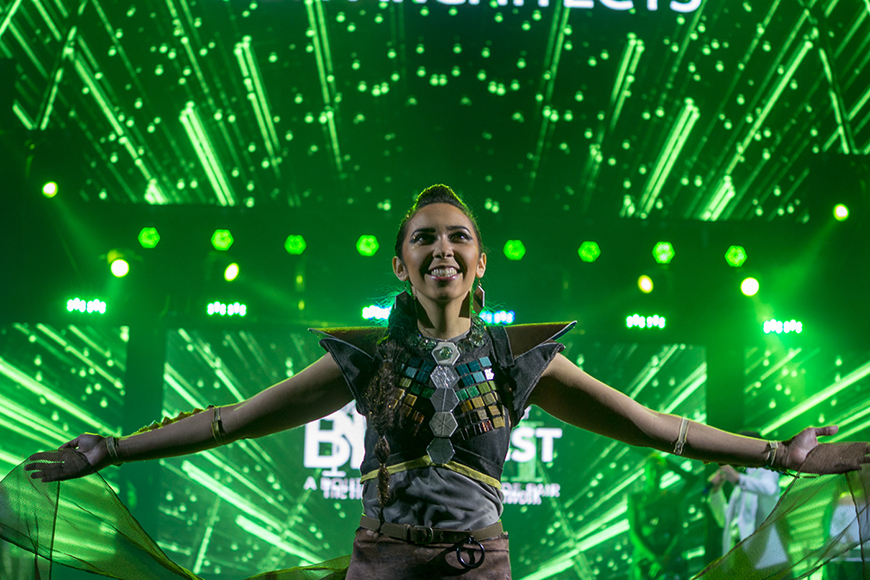One look at JAB Anstoetz’s 58th Street window display at the DDB and you may think you’re across the street at Bloomingdales, but don’t worry, you’re in the right place!
This season, JAB Anstoetz’s window is the chic result of design and fashion worlds colliding. It all began when JAB generously donated their textiles to the NEWH (Network of Executive Women in Hospitality) Design Challenge in LA, in connection with the BDWest Hospitality Show. This challenge offered participating design firms the opportunity to showcase their skills, creating couture fashions crafted from donated pieces of tile, carpet samples and other reusable design elements. The proceeds from the event benefit future NEWH scholarships.
In a (fashionable) chicken and egg-like scenario, these materials inspired the MBH Architects group, while their fashion design ultimately inspired the JAB window. But each scene began with the same story.

During the conceptual design phase of the challenge, MBH Arch developed the name for the design, “deSErt ROSE.”
“We toyed with several overarching themes to provide an armature of the story we were looking to tell and ultimately the beauty and imagery of a desert rose really resonated with us.” Patrycja Dragan, the team lead said. “We wanted our piece to tell the story of an individual who, despite any hardships, turned their circumstances into something beautiful and an opportunity for growth.”
To MBH’s team, the desert rose became a symbolic structure that crystalizes in harsh circumstances with minimal resources. In addition, another layer of meaning was found within the word ‘rose,’ as another group member found duality in not only a literal rose, but also rose in the sense of having risen up.

The next step for the team was how to physically represent the identity of these ideas. To Dragan, the ideas of ‘transformative, crystalline, and mosaic’ were easier to represent than those with less physical characteristics such as ‘empowering, resilience and strength.’ To inform these challenges, the students reviewed case studies of design precedents that had previously translated these ideas into built works.

Caroline Vaughn, the showroom manager of JAB Anstoetz at the DDB created the window based on the story behind the fashion. “We wanted to create a ‘musuem’ style installation to celebrate the story behind the fashion and at the same time continue the overall deSErt ROSE theme through the window.”
In order to do so, within the window, a large drape of JAB’s Marble Hill fabric, covering the floor with actual sand and rocks and JAB’s animal-inspired wallcovering contributed to the Rose’s landscape.

“We set the perfect stage for the deSErt ROSE ‘gracefully emerging from the arid context’ from the center of the window,” Vaughn said. To Vaughn, this creation could be the “fashion of the future. Bridging the gap between fashion and interior design – utilizing what you have on hand for both your survival, home and clothing.”
The first completed component of the ensemble was a JAB fabric skirt. Its texture eluded to the desert sands, while a matching sheer wall covering transformed into a fluid train for Kenia, the group’s model.

Additionally, the talented team broke down wood furniture samples into wood grains, while team member Brittany Cooper-Wilson used her jewelry making experience to create accent pieces along the bodice.
For these architects, the most challenging aspect of the process was balancing framing their models figure, while allowing the materials to speak for themselves. The donated fabric’s thickness caused difficulty in finding fluidity, but after countless hours of mock-ups and tests their original wide leg pant design was exchanged for the finished product.

“Having to let go of our preconceived notions of the materials and design was the greatest lesson we learned,” Dragan said.
Referring to this challenge as an “unconventional materials challenge” (for all you Project Runway fans), the team was faced with the challenge of transforming conventional materials and applying them to a different context, Dragan explained.
“Architecture and interior design capture the human body in a space, but a majority of the design principles regarding construction details, storytelling, and proportions can hold true on a micro scale when designing for the body itself,” said Dragan. “When a fashion designer or interior designer touches and looks at a textile they are ultimately deciding to use it based on whether it aligns with the story and emotional connection they are trying to share with their client.”

See fashion and interior design and a dash of ‘Mad Max’ vibes collide in the DDB 58th Street JAB Anstoetz window today.
MBH Architects Team:
Team Lead: Patrycja Dragan
Team Model: Kenia Stern
Brittany Cooper-Wilson
Stefani Johan
Carson Mallonée
Madison Parsons
Lawrence Ricardo
Shop the textiles used throughout this project at the DDB, Suite 102, PDC’s Thomas Lavin Showroom, Suite B309/310, and within the DCH’s ID Collection Showroom, Suite 4001.
